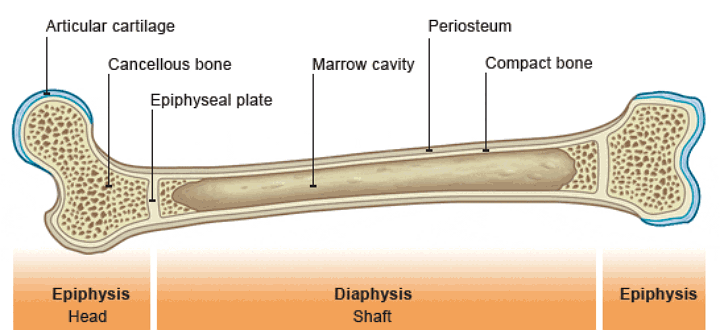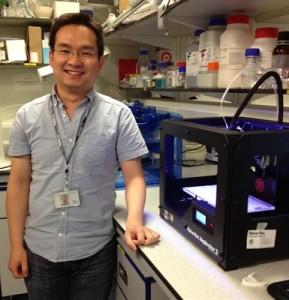 It looks a bit like bread dough, and a new bio-material which can be used to fill bone fractures holds the promise of being capable of forming a bond as strong as the spongy structures of human bone – and yet still allowing needed cells and proteins to pass through. Researchers at the University of Nottingham say it might one day be ideal for bone reconstruction, and the material can contain proteins within it which can promote healing.
It looks a bit like bread dough, and a new bio-material which can be used to fill bone fractures holds the promise of being capable of forming a bond as strong as the spongy structures of human bone – and yet still allowing needed cells and proteins to pass through. Researchers at the University of Nottingham say it might one day be ideal for bone reconstruction, and the material can contain proteins within it which can promote healing.
Dr. Jing Yang says the work on 3D printing human tissues for regenerative medical applications uses living cells and biomaterials placed at precise locations to mimic the natural organization of cells. Yang says such “engineered tissues” mimic their naturally-occurring counterparts in the body, and that they may well be capable of superior functionality.
According to Yang, the paste-like bone replacement material can be mixed at room temperature. It’s made of L-lactic-co-glycolic acid and polyethylene glycol carried within a fluid.
“Bioprinting is a hot research area in tissue engineering. It usually requires a printing environment that isn’t compatible with living cells – and those materials that are compatible with living cells usually don’t have sufficient mechanical properties for certain applications,” Yang says.
But this new technique and material allows for bioprinting at ambient temperatures and incorporates protein-carrying microspheres which can be injected with a syringe. Yang says the material should be able to withstand stresses and strains very like the cancellous bone it’s meant to replace.
The research findings were published in the journal Biofabrication, and the team says that it is the inclusion of cells and proteins to speed the healing of large fractures is key to the process.
“We’re targeting the clinical application of this material as injectable bone defect filler, but we’ve postulated that its properties would make it highly suitable for use as a scaffold to reconstruct larger shapes, which could help with more complicated reconstructions – such as nasal reconstruction,” Yang says.
 These pastes can cure at the normal human body temperature of approximately 98 degrees, and they form porous solid structures which make them compatible with the inclusion of cells and bio-molecules. The use of hydrogel materials in many orthopedic applications has become relatively common, but their mechanical properties are generally inferior to those of bone and they lack the proper stiffness. The PLGA-PEG microparticles were placed within aqueous carrier fluids to create dense pastes and then incubated in a humidified environment for two hours. The pastes were then submersed in sodium chloride for another 22 hours.
These pastes can cure at the normal human body temperature of approximately 98 degrees, and they form porous solid structures which make them compatible with the inclusion of cells and bio-molecules. The use of hydrogel materials in many orthopedic applications has become relatively common, but their mechanical properties are generally inferior to those of bone and they lack the proper stiffness. The PLGA-PEG microparticles were placed within aqueous carrier fluids to create dense pastes and then incubated in a humidified environment for two hours. The pastes were then submersed in sodium chloride for another 22 hours.
Yang says work done in the past has demonstrated that proteins and cells can tolerate and survive through the mixing and extrusion processes and that the “microporosity” of the finished constructs can aid tissue ingrowth.
The work represents the initial assessment of the technique and used a Fab@Home bioprinter in conjunction with the PLGA-based, microparticle pastes.
 Have you heard of any other promising work being done in bioprinting? Let us know in the Bone Repair 3D Printing Dough forum thread on 3DPB.com.
Have you heard of any other promising work being done in bioprinting? Let us know in the Bone Repair 3D Printing Dough forum thread on 3DPB.com.
Subscribe to Our Email Newsletter
Stay up-to-date on all the latest news from the 3D printing industry and receive information and offers from third party vendors.
You May Also Like
IperionX Inks 10-Year Deal with Wisconsin Manufacturer for 80 Metric Tons of Titanium Per Year
IperionX, the Charlotte-based supplier of sustainable titanium powders used for additive manufacturing (AM) and metal injection molding (MIM), has signed a ten-year deal with United Stars, a group of industrial...
Gastronology Launches Industrial Production of 3D Printed Food for Dysphagia Patients
Food 3D printing has, in many ways, been an additive manufacturing (AM) segment looking for the right business case. While some applications are beautiful and others may or may not...
Lockheed Martin Leads $3M Investment in Q5D’s Electronics 3D Printing System
Q5D, an original equipment manufacturer (OEM) of robotic arm, hybrid additive manufacturing (AM) systems used for wire harness production, has closed a $3 million investment round. The investment arm of...
3D Printing News Briefs, April 6, 2024: Depowdering, Cybertruck Door Handles, & More
In today’s 3D Printing News Briefs, ioTech’s digital manufacturing CLAD technology is opening up opportunities for microelectronics and additive manufacturing. Hexagon and Raytheon Technologies commercially released the Simufact Additive Process...
































